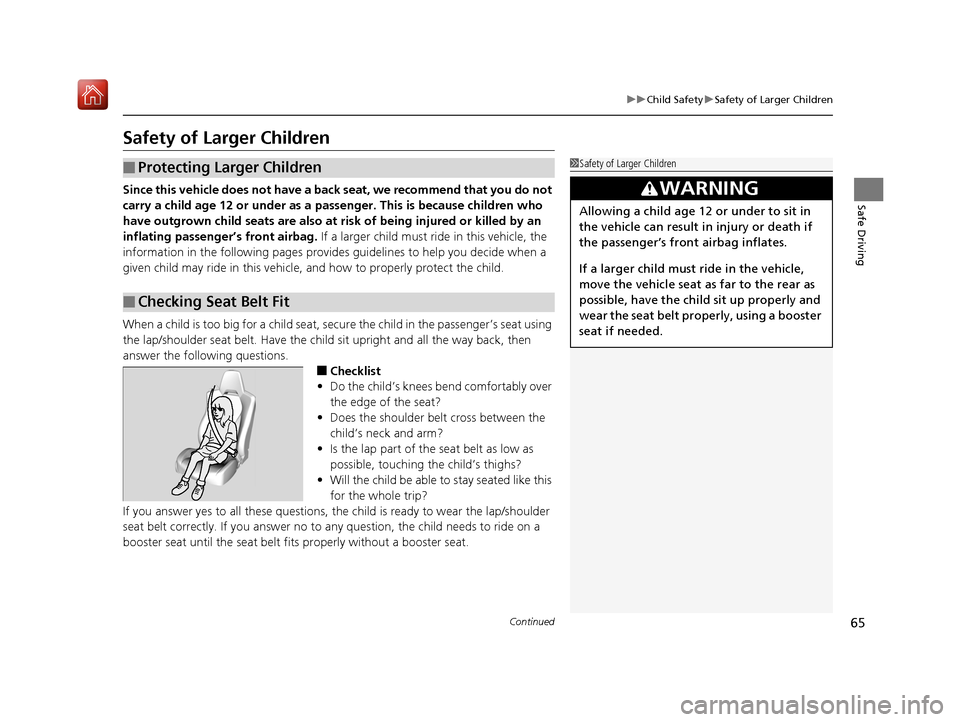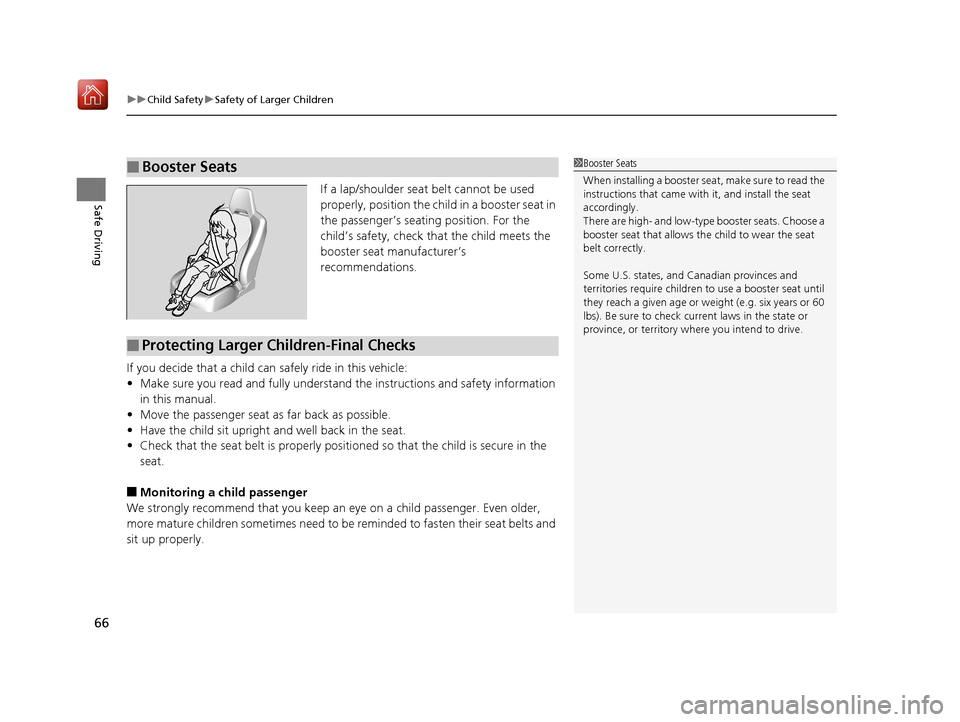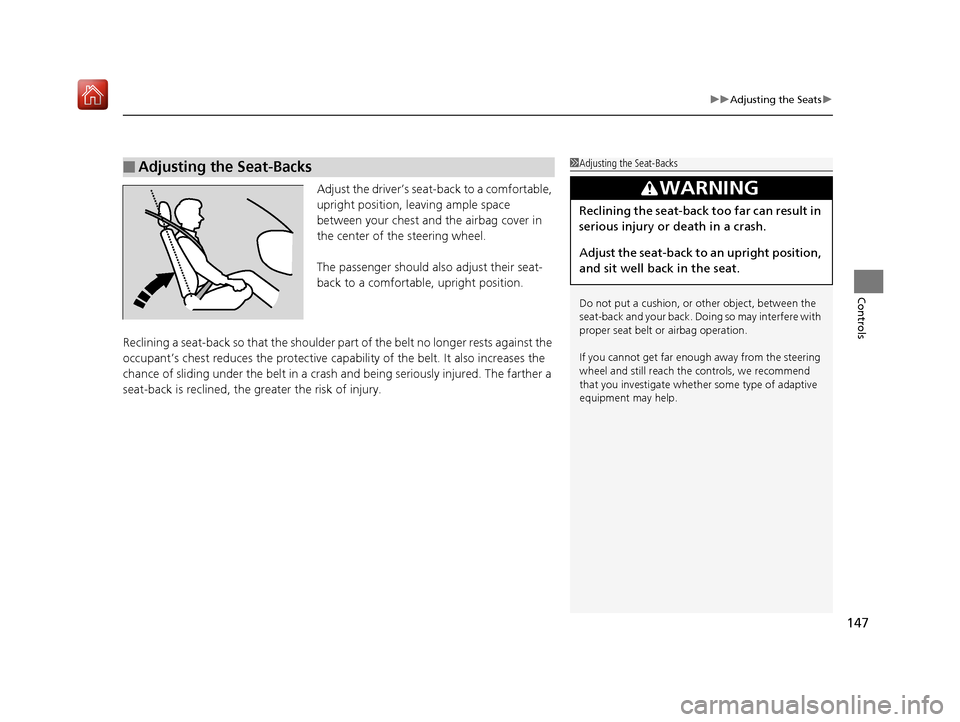Page 61 of 489
60
uuChild Safety uSafety of Infants and Small Children
Safe Driving
Safety of Infants and Small Children
An infant must be properly restrained in a rear-facing, reclining child seat until the
infant reaches the seat manufacturer’s weig ht or height limit for the seat, and the
infant is at least one year old. Because rear-facing child seats should not be
used in this vehicle, you should neve r carry an infant in this vehicle.
■Protecting Infants1Protecting Infants
Rear-facing child seats should never be installed in a
forward facing position.
3WARNING
Placing a rear-facing child seat in the
passenger’s seat can result in serious injury
or death during a crash.
Never install a rear-facin g child seat in this
vehicle.
18 NSX-31T6N6100.book 60 ページ 2017年10月27日 金曜日 午後1時39分
Page 66 of 489

65
uuChild Safety uSafety of Larger Children
Continued
Safe Driving
Safety of Larger Children
Since this vehicle does no t have a back seat, we recommend that you do not
carry a child age 12 or under as a pass enger. This is because children who
have outgrown child seats are also at risk of being injured or killed by an
inflating passenger’s front airbag. If a larger child must ride in this vehicle, the
information in the following pages provides guidelines to help you decide when a
given child may ride in this vehicle, and how to properly protect the child.
When a child is too big for a child seat, secu re the child in the passenger’s seat using
the lap/shoulder seat belt. Have the child sit upright and all the way back, then
answer the foll owing questions.
■Checklist
• Do the child’s knees bend comfortably over
the edge of the seat?
• Does the shoulder belt cross between the
child’s neck and arm?
• Is the lap part of the seat belt as low as
possible, touching the child’s thighs?
• Will the child be able to stay seated like this
for the whole trip?
If you answer yes to all these questions, th e child is ready to wear the lap/shoulder
seat belt correctly. If you answer no to any question, the child needs to ride on a
booster seat until the seat belt fits properly without a booster seat.
■Protecting Larger Children
■Checking Seat Belt Fit
1 Safety of Larger Children
3WARNING
Allowing a child age 12 or under to sit in
the vehicle can result in injury or death if
the passenger’s fron t airbag inflates.
If a larger child must ride in the vehicle,
move the vehicle seat as far to the rear as
possible, have the child sit up properly and
wear the seat belt properly, using a booster
seat if needed.
18 NSX-31T6N6100.book 65 ページ 2017年10月27日 金曜日 午後1時39分
Page 67 of 489

uuChild Safety uSafety of Larger Children
66
Safe DrivingIf a lap/shoulder seat belt cannot be used
properly, position the chil d in a booster seat in
the passenger’s seating position. For the
child’s safety, check th at the child meets the
booster seat manufacturer’s
recommendations.
If you decide that a child can safely ride in this vehicle:
• Make sure you read and fully understand the instructions and safety information
in this manual.
• Move the passenger seat as far back as possible.
• Have the child sit upright and well back in the seat.
• Check that the seat belt is properly positi oned so that the child is secure in the
seat.
■Monitoring a child passenger
We strongly recommend that you keep an eye on a child passenger. Even older,
more mature children sometimes need to be reminded to fasten their seat belts and
sit up properly.
■Booster Seats1 Booster Seats
When installing a booster seat, make sure to read the
instructions that came with it, and install the seat
accordingly.
There are high- and low-type booster seats. Choose a
booster seat that allows the child to wear the seat
belt correctly.
Some U.S. states, and Canadian provinces and
territories require children to use a booster seat until
they reach a given age or we ight (e.g. six years or 60
lbs). Be sure to check current laws in the state or
province, or territory where you intend to drive.
■Protecting Larger Children-Final Checks
18 NSX-31T6N6100.book 66 ページ 2017年10月27日 金曜日 午後1時39分
Page 104 of 489

103
Controls
This chapter explains how to operate the various controls necessary for driving.
Clock.................................................. 104
Locking and Unlocking the Doors Key Type and Functions ................... 105
Low Keyless Access Remote Signal Strength ......................................... 106
Locking/Unlocking the Doors from the
Outside .......................................... 107
Locking/Unlocking the Doors from the Inside ............................................. 115
Auto Door Locking/Unlocking .......... 118
Opening and Closing the Hatch....... 119
Security System ................................ 122
Immobilizer System .......................... 122 Security System Alarm...................... 122Opening and Closing the Windows.... 125Operating the Switches Around the
Steering Wheel ENGINE START/STOP Button............. 127
Turn Signals ..................................... 130
Light Switches.................................. 131
Daytime Running Lights ................... 134
Wipers and Washers ........................ 135
Brightness Control ........................... 136
Rear Defogger/Heated Door Mirror Button.....137Driving Position Memory System*.... 138
Adjusting the Steering Wheel........... 140 Adjusting the Mirrors
....................... 141
Interior Rearview Mirror ................... 141
Power Door Mirrors ......................... 142
Adjusting the Seats .......................... 144
Interior Lights/Interior Convenience Items ................................................ 149
Interior Lights .................................. 149
Interior Convenience Items .............. 151
Climate Control System ................... 156
Using Automatic Climate Control .... 156Automatic Climate Control Sensors......160
* Not available on all models
18 NSX-31T6N6100.book 103 ページ 2017年10月27日 金曜日 午後1時39分
Page 145 of 489

144
Controls
Adjusting the Seats
Adjust the driver’s seat as far back as possible
while allowing you to maintain full control of
the vehicle. You should be able to sit upright,
well back in the seat and be able to
adequately depress the pedals without
leaning forward, and grip the steering wheel
comfortably. The passenger’s seat should be
adjusted in a similar manner, so that it is as far
back from the front airbag in the dashboard
as possible.
■Adjusting the power seats*
1Adjusting the Seats
The National Highway Traffic Safety Administration
and Transport Cana da recommend that drivers allow
at least 10 inches (25 cm) between the center of the
steering wheel and the chest.
Always make seat adjustments before driving.
3WARNING
Sitting too close to a front airbag can result
in serious injury or death if the front
airbags inflate.
Always sit as far back from the front
airbags as possible while maintaining
control of the vehicle.
Move back.
Allow sufficient
space.
■Adjusting the Seat Positions
Horizontal
Position
Adjustment
Seat-back Angle
Adjustment
Driver’s seat is shown.
* Not available on all models
18 NSX-31T6N6100.book 144 ページ 2017年10月27日 金曜日 午後1時39分
Page 146 of 489
145
uuAdjusting the Seats u
Continued
Controls
■Lumbar Support Adjustment Switch*
Press the top: To increase the higher part of
the lumbar support.
Press the bottom: To increase the lower part
of the lumbar support. (The higher part
support is decreased.)
Press the front: To increase the entire
lumbar support.
Press the rear: To decrease the entire lumbar
support.Higher part of
the Lumbar
support
Lumbar
Support
Adjustment
Switch
Lower part of
the Lumbar
support
* Not available on all models
18 NSX-31T6N6100.book 145 ページ 2017年10月27日 金曜日 午後1時39分
Page 147 of 489
uuAdjusting the Seats u
146
Controls
■Adjusting the manual seats*1Adjusting the manual seats*
Once a seat is adjusted co rrectly, rock it back and
forth to make sure it is locked in position.
Horizontal Position
Adjustment
Pull up on the bar to move the
seat, then release the bar.
Seat-back Angle
Adjustment
Pull up the lever to
change the angle.
Driver’s seat is shown.
* Not available on all models
18 NSX-31T6N6100.book 146 ページ 2017年10月27日 金曜日 午後1時39分
Page 148 of 489

147
uuAdjusting the Seats u
Controls
Adjust the driver’s seat -back to a comfortable,
upright position, leaving ample space
between your chest and the airbag cover in
the center of the steering wheel.
The passenger should also adjust their seat-
back to a comfortable, upright position.
Reclining a seat-back so that the shoulder part of the belt no longer rests against the
occupant’s chest reduces the protective capa bility of the belt. It also increases the
chance of sliding under the belt in a crash and being seriously injured. The farther a
seat-back is reclined, the gr eater the risk of injury.
■Adjusting the Seat-Backs1Adjusting the Seat-Backs
Do not put a cushion, or other object, between the
seat-back and your back. Do ing so may interfere with
proper seat belt or airbag operation.
If you cannot get far e nough away from the steering
wheel and still reach th e controls, we recommend
that you investigate whether some type of adaptive
equipment may help.
3WARNING
Reclining the seat-back too far can result in
serious injury or death in a crash.
Adjust the seat-back to an upright position,
and sit well back in the seat.
18 NSX-31T6N6100.book 147 ページ 2017年10月27日 金曜日 午後1時39分